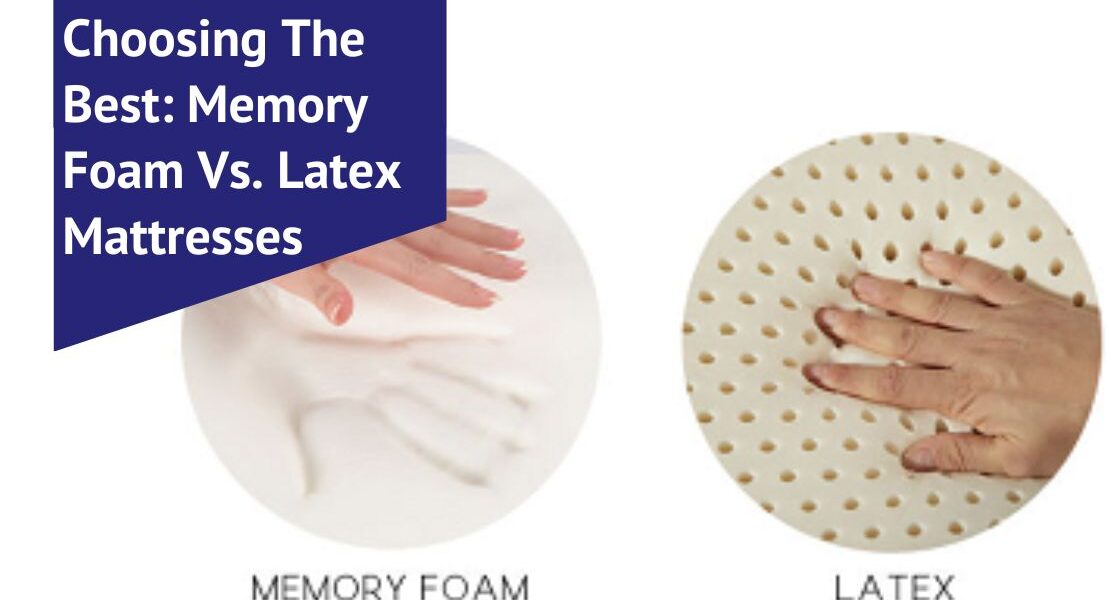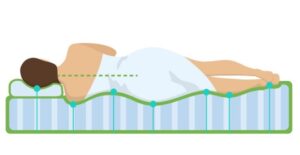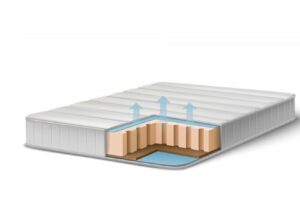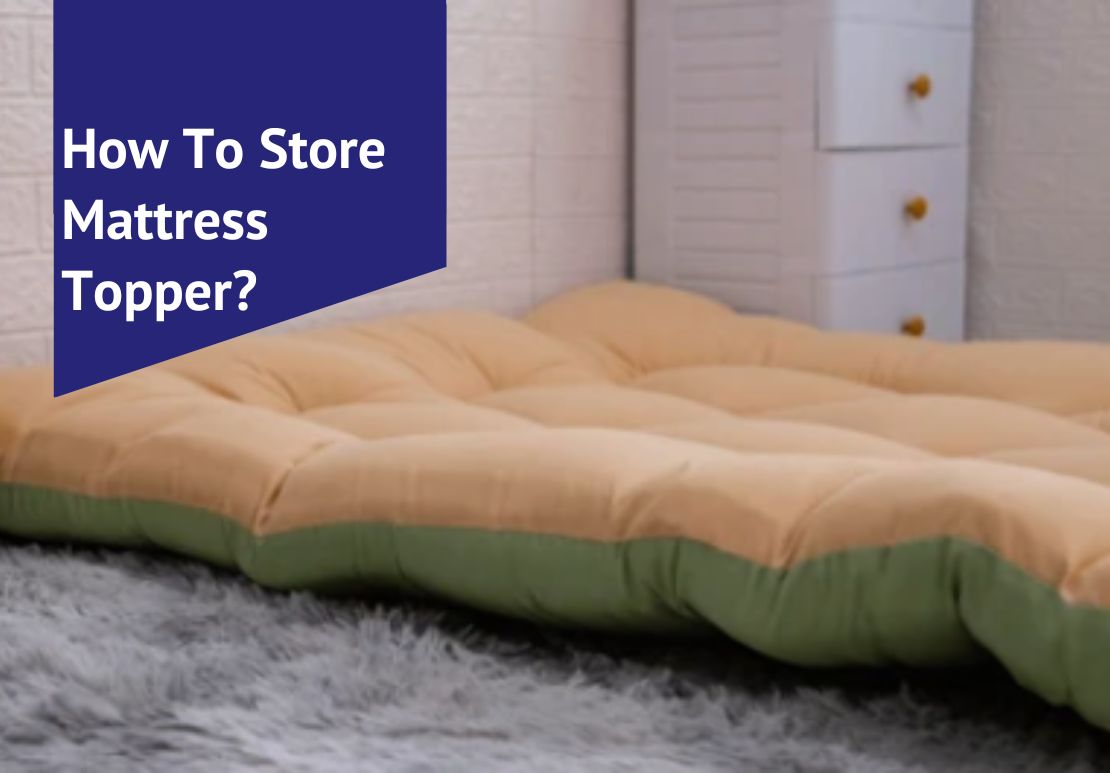Finding the perfect mattress can be challenging, with many options clouding decision-making. One key debate in the mattress industry centers around memory foam versus latex mattresses, each boasting its unique benefits for sleepers.
This article will delve into comparing these two types, examining factors such as comfort, durability, and support to assist readers in making an informed choice. Discover your ideal sleep surface as we navigate the complexities of memory foam and latex beds.
Table of Contents
Key Takeaways
- Memory foam mattresses are known for their pressure relief and contouring abilities, ideal for reducing back pain but can retain heat, which may not suit people who get too warm during sleep.
- Due to sustainable harvesting methods, latex foam mattresses offer durable and breathable options with a more responsive feel, making them suitable for hot sleepers and eco-conscious individuals.
- Consider personal factors like sleeping position, temperature preferences, allergy sensitivities, desired mattress response, and movement isolation when choosing between memory foam and latex mattresses.
What is Memory Foam?
Memory foam, developed in the mid-1960s for NASA airplane seats, is made from viscoelastic. It’s both high energy absorbent and soft; memory foam molds to the body in response to heat and pressure, evenly distributing body weight.
Once you remove the pressure, it returns to its original shape, which makes it a popular choice for bedding materials, including mattresses, pillows, and mattress toppers.
One remarkable feature of memory foam mattresses is their ability to conform closely to one’s body contours, offering unmatched pressure relief and support during sleep. This capacity aids in cushioning sensitive areas such as hips and shoulders while keeping your spine correctly aligned – key factors that can contribute significantly to reducing back pain.
Memory foam beds are known for retaining warmth due to their dense structure, which benefits those who favor a cozier sleep environment but may not suit hot sleepers without additional cooling technology incorporated into the mattress design.
What is Latex Foam?
Latex foam is a material used in mattresses that offers a distinct combination of support and comfort. Harvested from the sap of rubber trees, natural latex is processed using the Dunlop or Talalay method to create a buoyant and responsive sleep surface.
Latex’s innate elasticity lends a more generalized hug around the sleeper’s body compared to memory foam, allowing for easy movement during sleep with quick response time and enhanced bounce.
Mattresses made from latex foam are valued for their durability; some can last up to two decades with proper care. This resilience stems from latex’s ability to resist sagging and maintain its shape over many years, providing consistent support night after night.
In addition, they are ideal for individuals who tend to sleep hot as latex does not retain heat like memory foam, aiding in temperature regulation throughout the night. It’s worth noting these mattresses are often recommended for those seeking an eco-friendly bedding option due to the sustainable nature of harvesting rubber sap without harming the trees.
What is a better latex or memory foam mattress?
When comparing latex and memory foam mattresses, it’s important to consider factors such as support, breathability, motion transfer, responsiveness, feel, hypoallergenic properties, durability, sustainability, price, and availability.
To understand the differences and decide which type of mattress is best for you, continue reading.
Support
Memory foam mattresses stand out for their ability to contour precisely to the body, offering unmatched pressure relief and support where needed most. This cradling effect can be especially beneficial for individuals with back pain as it helps maintain proper spinal alignment throughout the night.
On the other side, latex provides a different kind of support; its natural elasticity contributes to a supportive yet buoyant feel. Sleepers will notice that latex pushes back more firmly against the body, lending itself to an even distribution of weight and reducing sinkage.
Natural latex maintains consistent support over the years without losing shape or resilience, which is crucial for a restful sleep experience. Memory foam might offer immediate comfort by adapting to your form but tends to sag more over time than its latex counterpart.
Carefully considering both materials’ supportive properties is essential in finding the mattress best suited for individual needs, ensuring long-lasting comfort and improved sleep quality.
Breathability
Latex mattresses are known for their superior breathability, allowing for better airflow and heat dissipation than memory foam. This makes latex a favorable choice for hot sleepers who want to stay cool overnight.
Natural latex is inherently breathable due to its open-cell structure, preventing body heat retention and promoting a more comfortable sleeping environment.
On the other hand, memory foam tends to retain body heat, potentially causing discomfort for those sensitive to temperature changes during sleep. While some memory foam mattresses incorporate cooling technologies to address this issue, overall breathability remains one of the key advantages of latex mattresses compared to memory foam options.
Motion transfer
When it comes to motion transfer, both memory foam and latex mattresses have their characteristics. Memory foam excels in isolating motion due to its ability to absorb and distribute movement across the bed’s surface.
This makes it an ideal choice for couples sensitive to each other’s movements during sleep, as it minimizes disturbances caused by tossing and turning.
On the other hand, while latex also provides decent motion isolation, its higher responsiveness can result in slightly more noticeable movement transfer compared to memory foam. However, natural latex with denser compositions tends to mitigate this effect better than synthetic or blended latex options.
Responsiveness
When it comes to the comparison of memory foam and latex mattresses, another crucial factor to consider is responsiveness. Latex mattresses are known for their quick response time and elasticity, providing a more generalized hug than memory foam.
This characteristic results in a faster bounce back when pressure is applied, contributing to a bouncier feel. On the other hand, memory foam has a slower response time and conforms more specifically to body shape, which can provide targeted support in certain areas.
The differences in responsiveness between latex and memory foam play a significant role in how each mattress feels during sleep and adjusts to movements throughout the night.
Feel
Homeowners will notice distinct differences in the feel of memory foam versus latex mattresses. Memory foam offers a contouring and cradling sensation, providing pressure relief and support by molding to the body’s shape.
This tends to create a sinking or hugging feeling, which some individuals find comforting for back pain or pressure points. On the other hand, latex mattresses have a more responsive and resilient feel, with natural buoyancy that allows for easy movement and repositioning during sleep.
The bouncy nature of latex provides a floating sensation without compromising on support.
Hypoallergenic
Latex mattresses are naturally hypoallergenic, making them an excellent choice for individuals with allergies or sensitivities. The antimicrobial and dust mite-resistant properties of latex make it an ideal option for those seeking a clean and healthy sleep environment.
Unlike memory foam, which may contain synthetic materials that can trigger allergic reactions, natural latex provides a hypoallergenic surface that promotes better air quality and overall well-being.
Given its resistance to mold, mildew, and other common allergens, latex mattresses are particularly beneficial for homeowners prioritizing allergy-free sleeping experiences. With their hypoallergenic qualities, latex mattresses offer a comfortable and health-conscious solution for individuals looking to minimize potential irritants within their bedroom environment.
Durability
Memory foam mattresses typically have a useful lifespan of around 7-10 years, while natural latex mattresses can last up to 20 years with proper care. Latex is known for its exceptional durability and ability to retain shape and support over time.
This quality makes latex mattresses an excellent long-term investment, especially for homeowners seeking a durable and resilient sleep surface. Additionally, the consistent support provided by natural latex ensures that the mattress maintains its structural integrity, making it less susceptible to sagging than memory foam.
Given latex mattresses’ longer lifespan and resilience, they are well-suited for individuals who prioritize durability and longevity in their bedding choices. Homeowners looking for a mattress that withstands wear and tear over the years may find that natural latex offers substantial value as it outlasts memory foam in terms of durability and overall longevity.
Sustainability
When considering the environmental impact of mattresses, sustainability becomes a crucial factor for many homeowners. Natural latex mattresses are often considered more eco-friendly than memory foam due to their biodegradability and renewable sourcing.
Latex is derived from rubber tree sap, a sustainable resource that can be harvested without harming the trees. Natural latex mattresses are also free from harmful chemicals and toxins, promoting a healthier sleeping environment for individuals and the planet.
On the other hand, some memory foam mattresses may contain synthetic materials that contribute to environmental pollution and waste. Making an informed decision on mattress material aligns with environmentally conscious choices.
Price
Latex mattresses generally have a higher price point than memory foam options due to the cost of materials and production. Natural latex, in particular, tends to be more expensive compared to synthetic or blended versions.
Homeowners must consider their budget and long-term investment when weighing the affordability of memory foam and latex mattresses. While memory foam may offer more budget-friendly options, it’s crucial to consider durability and lifespan.
When comparing prices between memory foam and latex mattresses, homeowners should assess each type’s value based on their specific sleep needs and preferences. Understanding the potential trade-offs between upfront costs and long-term benefits can help individuals make informed decisions that align with their financial considerations.
Availability
Memory foam mattresses are widely available and can be found in a variety of brick-and-mortar stores as well as online retailers, providing homeowners with numerous options to choose from.
Memory foam mattress models also come in various firmness levels and sizes, catering to different preferences and room dimensions. With its popularity on the rise, many manufacturers offer memory foam mattresses at varying prices, making them accessible to individuals with different budget constraints.
On the other hand, latex mattresses may have slightly limited availability compared to memory foam options. Homeowners seeking latex mattresses may find them predominantly through specialty sleep stores or directly from manufacturers rather than at mainstream retailers.
How to Choose the Right Mattress for You
Consider your sleeping position, temperature regulation needs, allergies, conformity to body shape, and motion transfer properties when choosing between memory foam and latex mattresses.
These factors will help you determine which type of mattress best suits your needs and preferences.
Sleeping positions
Adjusting sleeping positions to accommodate different mattress types is crucial for a restful night’s sleep. For back sleepers, memory foam, and latex mattresses can offer excellent support by contouring the body’s shape and ensuring proper spinal alignment.
Side sleepers may find that memory foam mattresses relieve pressure on their hips and shoulders, while latex mattresses with varying firmness levels could cater to individual preferences.
Stomach sleepers may benefit from firmer latex mattresses that prevent excessive sinking and maintain spinal alignment, promoting more comfortable slumber.
Temperature regulation
Memory foam mattresses are known for retaining body heat, potentially causing discomfort for those who sleep hot. On the other hand, latex mattresses are less likely to cause overheating, making them a favorable choice for individuals who struggle with temperature regulation while sleeping.
This aspect can significantly impact overall comfort and quality of sleep.
When selecting a mattress based on temperature regulation, one must consider individual sleeping habits and preferences to ensure a restful and comfortable night’s sleep.
Allergies
Latex mattresses are naturally hypoallergenic, making them an excellent choice for homeowners prone to allergies. The material is resistant to dust mites and mold, reducing the risk of allergic reactions while providing a healthy sleeping environment.
On the other hand, memory foam can potentially harbor allergens such as dust mites due to its dense composition.
Considering these factors, individuals with specific allergy concerns may find latex mattresses more suitable for minimizing potential triggers and ensuring a comfortable sleep experience.
Conformity
When choosing a mattress, it’s essential to consider how well it conforms to your body. Memory foam and latex both offer varying levels of conformity. Memory foam mattresses are known for their ability to contour and adapt to the body’s shape, providing personalized support and pressure relief.
On the other hand, natural latex also offers excellent conformity by gently molding to the body’s contours while maintaining consistent support over time. Both memory foam and latex mattresses excel in conforming to the sleeper’s shape, delivering a comfortable and customized sleeping experience tailored to individual preferences.
Memory foam boasts exceptional conformity as it molds precisely to the sleeper’s body shape, relieving pressure points and offering unparalleled comfort during sleep. Meanwhile, natural latex provides impressive conformity by gently enveloping the body while sustaining responsive support throughout the night for a restful slumber.
Motion transfer properties
Memory foam mattresses have excellent motion isolation properties, meaning that movements on one side of the bed are less likely to be felt on the other side. This can be particularly beneficial for couples or anyone easily disturbed by their partner’s movements during sleep.
On the other hand, latex mattresses also offer good motion transfer properties, although they may not eliminate movement across the bed.
When it comes to motion transfer properties, memory foam generally outperforms in isolating movement and reducing disturbances during sleep. However, memory foam and latex mattresses provide reasonable levels of motion isolation for undisturbed rest.
Pros and Cons of Memory Foam
Memory foam mattresses offer excellent pressure relief and conform to the body, making them ideal for joint or back pain patients. However, they may retain body heat and lack responsiveness for some sleepers.
What are the advantages of a memory foam mattress?
Memory foam mattresses can conform to the body’s shape, relieving pressure for aching joints and muscles. They offer unparalleled support, distributing body weight evenly to alleviate discomfort. This type of mattress helps reduce motion transfer, ensuring disturbance-free sleep for couples. Memory foam mattresses can also be hypoallergenic, making them ideal for individuals with allergies or sensitivities. Moreover, memory foam mattresses are known for their durability and ability to retain their shape over time.
- It conforms to the body’s shape, providing personalized comfort and pressure relief.
- Distributes body weight evenly to reduce pressure points and alleviate discomfort.
- Minimizes motion transfer for undisturbed sleep, which is especially beneficial for couples.
- Hypoallergenic properties make it suitable for individuals with allergies or sensitivities.
- Exhibits durability and retains its shape over an extended period.
What are the disadvantages of a memory foam mattress?
Memory foam mattresses have some disadvantages to consider before making a purchase. Here are the key drawbacks to bear in mind:
- Retains Body Heat: Memory foam tends to retain body heat, potentially causing discomfort for those who sleep hot or live in warmer climates.
- Chemical Odor: Some memory foam mattresses may emit an initial chemical odor when unpacked, which can take time to dissipate.
- Lack of Firmness Options: Memory foam mattresses may not offer as wide a range of firmness options as other types of mattresses, limiting choices for those with specific preferences.
- Weight Sensitivity: In some cases, memory foam mattresses might not be suitable for individuals who find it challenging to move or turn in bed due to the material’s response and conforming properties.
- Longevity Concerns: Over time, memory foam mattresses can experience sagging and reduced support due to the nature of the material.
Pros and Cons of Latex Foam
Latex foam mattresses offer excellent support and durability, making them popular for those seeking long-term comfort. However, they can be more expensive than memory foam options and may not conform as closely to the body’s shape.
Understanding these factors helps individuals decide when considering latex foam mattresses.
What are the advantages of a latex mattress?
A latex mattress offers several advantages over other types of mattresses. It provides excellent support and pressure relief, ideal for those with back pain or joint issues. Additionally, latex mattresses are highly durable and can last up to 20 years with proper care. They’re also naturally hypoallergenic and resistant to dust mites, mold, and mildew, making them an excellent choice for allergy sufferers. Latex mattresses are known for their eco-friendly properties, as natural latex is sustainably sourced from rubber trees.
Furthermore, they offer excellent temperature regulation, keeping sleepers cool throughout the night. The responsive nature of latex foam ensures ease of movement and reduces motion transfer for undisturbed sleep. In terms of sustainability and eco-friendliness, latex mattresses win out over many other options due to their biodegradability and renewable materials used in production.
What are the disadvantages of a latex mattress?
It’s essential to consider potential downsides when making an informed decision when transitioning from the advantages to the drawbacks of a latex mattress. Homeowners should be aware of the following disadvantages:
- Limited Availability: Unlike memory foam mattresses, which are widely available, natural latex mattresses may be harder to find in traditional retail outlets due to their specialized manufacturing process.
- Price Point: Natural latex mattresses are more expensive than memory foam options, making them less accessible for homeowners on a budget.
- Weight: Latex mattresses are heavier than other beds, making moving and handling them more challenging.
- Allergens: Some individuals may have allergic reactions to proteins found in natural latex, posing a potential health concern for sensitive sleepers.
- Initial Odor: Newly purchased latex mattresses might emit a natural rubber scent that could be bothersome and require dissipating time.
- Firmer Feel: For those who prefer a softer sleeping surface, the inherent firmness of natural latex may not provide the desired level of comfort.
- Motion Transfer: While latex has less motion transfer than innerspring mattresses, it may not absorb movement as effectively as memory foam, potentially disrupting sleep for light sleepers sharing the bed.
- Break-in Period: It may take some time for a latex mattress to adjust and conform to the sleeper’s body fully, leading to an initial period of discomfort for some users.
- Environmental Impact: The production of natural latex can have environmental implications if manufacturers do not rigorously enforce sustainability practices.
Conclusion
Considering the differences between memory foam and latex mattresses, weighing their unique features against individual preferences and needs is crucial. Memory foam conforms to the body’s shape, providing pressure relief and support.
On the other hand, latex boasts greater durability, elasticity, and breathability compared to memory foam. Homeowners should carefully evaluate factors like firmness, support level, motion transfer properties, allergy sensitivity, sustainability concerns, and personal sleeping positions before choosing a mattress that best suits their needs.
FAQs – Frequently Asked Questions
Memory foam mattresses contour your body, while latex mattresses provide a more responsive and bouncy feel.
Latex mattresses are naturally hypoallergenic and resistant to dust mites and mold, making them an excellent choice for allergy sufferers.
Memory foam mattresses generally have a shorter lifespan than latex mattresses, known for their exceptional durability.
Latex mattresses have an open-cell structure that allows for better airflow, making them cooler than traditional memory foam options.
Memory foam and latex mattresses can be used with any bed frame, such as platform beds, slatted frames, or adjustable bases. However, it is important to ensure that the bed frame provides adequate support and ventilation for the specific type of mattress to prevent premature wear and tear.
For side sleepers, memory foam is often the preferred choice because it can contour the body's shape and provide tailored support for the shoulders and hips. Latex, on the other hand, offers a bit more responsiveness and bounce, which can benefit some side sleepers who prefer a little more lift. What are the main differences between memory foam and latex mattresses?
Which type of mattress is better for people with allergies or sensitivities?
How do memory foam and latex mattresses differ in durability?
Do memory foam or latex mattresses offer better temperature regulation?
Can I use any type of bed frame with both memory foam and latex mattresses?
Which is better for side sleepers, memory foam or latex?

 Image source -latexmattress
Image source -latexmattress 








